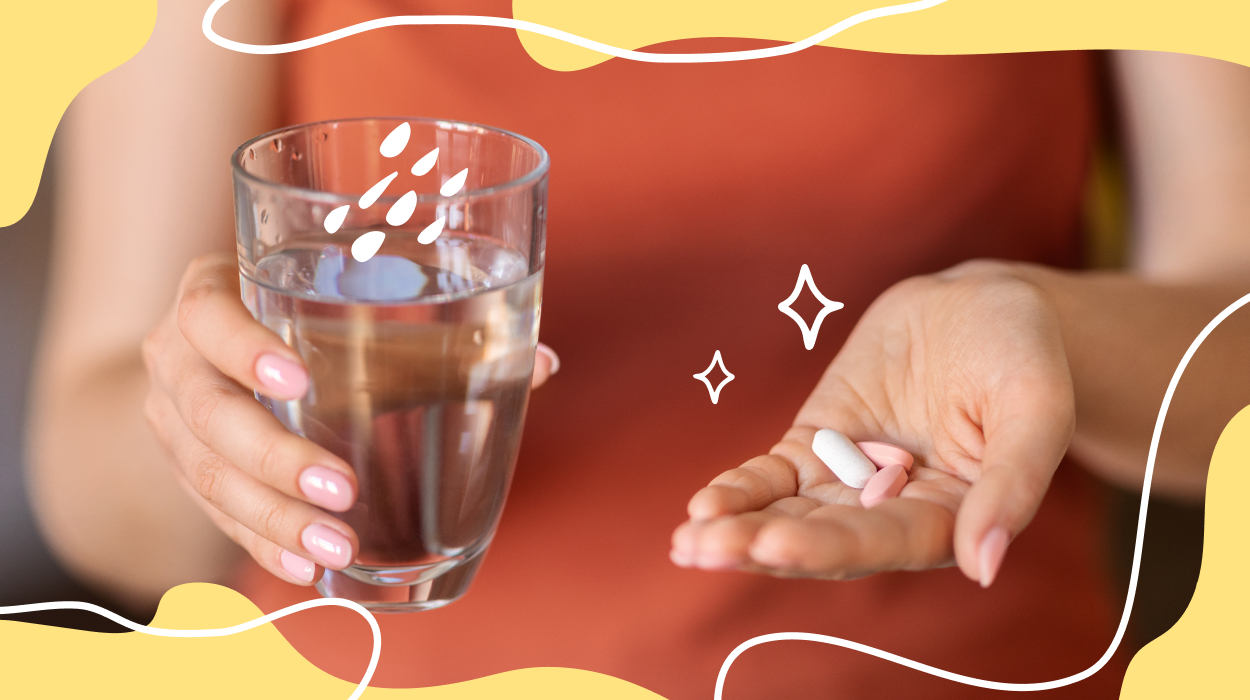 Expert's opinion
Expert's opinion
Expert's opinion
The article is a subjective view on this topic written by writers specializing in medical writing.
It may reflect on a personal journey surrounding struggles with an illness or medical condition, involve product comparisons, diet considerations, or other health-related opinions.
Although the view is entirely that of the writer, it is based on academic experiences and scientific research they have conducted; it is fact-checked by a team of degreed medical experts, and validated by sources attached to the article.
The numbers in parenthesis (1,2,3) will take you to clickable links to related scientific papers.
Should You Use A Muscle Relaxer For Kidney Stones?

Kidney stones are a prevalent problem that affect millions of people worldwide. Research has shown that 5-15% of the global population[1] will experience a kidney stone in their lifetime.
Kidney stone pain can vary from a dull ache to excruciating stabbing sensations, often sending sufferers to the emergency room. Pain is thought to be caused by the combination of alternating spasms of the urinary tract muscles and the backup of urine due to obstruction.
The muscle spasms of the urinary tract have led many scientists to wonder if a muscle relaxer can help kidney stone pain. Medications to relax the muscles in the urinary tract have been available for some time, but there have been conflicting evidence regarding their efficacy. Recently, researchers at Massachusetts General Hospital and Massachusetts Institute of Technology[2] (MIT) have hypothesized that by combining certain medications and applying them directly to the urinary tract they could significantly ease pain and assist in kidney stone passage.
In this article, we will discuss how to get rid of kidney stones, the current pain management options, and dive deep into the scientific research behind current treatments and the new medications in the pipeline.
Will A Muscle Relaxer Help Kidney Stone Pain?
Kidney stone pain is caused by the contraction of muscles in the urinary system[3], so it makes sense that medications with muscle-relaxing properties ease this pain. Initially, treatment with muscle relaxants[4] such as alpha blockers and calcium channel blockers were found to be effective and safe. There has been some conflicting evidence on these medications over the years. Researchers have continued exploring effective stone passage treatments, with groundbreaking research at MIT uncovering a potential new treatment option.
Overview Of Kidney Stone Pain

Pain is the most common symptom of a kidney stone[5]. This pain can vary from a mild ache that is barely noticed to severe pain requiring an emergency room visit.
Pain typically begins when the stone initially passes from the renal pelvis into the ureter. The ureter is a narrow tube that connects the kidneys to the bladder. Its small size makes it vulnerable to obstruction from larger stones.
The area where the stone is causing an obstruction often will correlate to the location of the pain[6]. Upper ureteral obstruction will lead to flank pain, while lower ureteral obstruction will result in pain in the groin area. As the stone migrates, the pain moves as well.
Kidney stone pain is primarily thought to occur due to urinary obstruction and muscle spasms. The ureter is lined by smooth muscle cells that rhythmically contract to move urine through the tube. When the muscles contract on a kidney stone, it can cause excruciating pain. Additionally, if the stone is blocking the urine flow, the kidney capsule can become dilated or enlarged, resulting in additional discomfort.
Will A Muscle Relaxer Help Kidney Stone Pain?

Muscle relaxants are thought to help with kidney stone expulsion and pain by relaxing ureteral muscles. As the muscles relax, the ureter will enlarge. Urine can pass through the ureter relieving pain from kidney capsule dilation. Additionally, when the rhythmic contractions stop, the pain from the muscle contractions will also let up. The relaxation of the smooth muscle cells is also thought to help stones pass through the urinary tract faster.
Current Treatments
Several medications are currently used for kidney stone treatment. This includes alpha-blockers (tamsulosin) and calcium channel blockers (nifedipine), which are known for their muscle relaxing effects. This is known as medical expulsive therapy[7] (MET). Initial studies[8] demonstrated that these medications were safe and effectively decreased the time until stone passage.
However, a large study from the UK[9] called the effectiveness of MET into question, showing no significant differences in stone passage, pain scores, or pain medication use between patients taking a placebo, tamsulosin, or nifedipine. This study certainly laid some foundation for doubt in MET. But since this time, multiple studies have shown MET to be effective. Most notably, a 2019 meta-analysis[10] published in The Journal of Urology found that MET is effective and safe for patients with kidney stones, reduces pain, results in fewer hospitalizations, and facilitates stone passage.
Recent Research
Researchers at MIT and Massachusetts General Hospital[11] (MGH) recently identified a combination of two drugs that target muscle relaxation. Christopher Lee, a recent Ph.D. recipient in the Harvard-MIT Division of Health Sciences and Technology, is the lead author of the study that was published in Nature Biomedical Engineering.
The team exposed several drugs to human ureteral cells grown in a lab dish. They hypothesized that if they delivered the muscle relaxant directly to the ureter, they could achieve a more significant relaxation effect than delivering them orally, like in MET.
The researchers analyzed the relaxation responses of nearly 1 billion cells after drug exposure through the use of intensive computational processing. They identified two muscle relaxants that worked exceptionally well and found that they worked even better when given together. One of these drugs is nifedipine, a calcium channel blocker used to treat high blood pressure, and the other is a type of drug known as a ROCK (rho kinase) inhibitor, which is used to treat glaucoma.
In this study, the researchers tested various doses of this combination of drugs in ureters removed from pigs. The studies demonstrated a dramatic reduction in the frequency and length of contractions of the ureter. Tests performed in live pigs also showed that the treatment nearly eliminated ureteral contractions. This drug combination is yet to be tested on human patients.
The findings from this study suggest that drugs delivered directly to the ureter may significantly reduce ureteral contractions. This drug combination may potentially lead to a new treatment option for kidney stone patients and those with other urological indications.
Other Ways To Ease Kidney Stone Pain
Besides muscle relaxants, there are other ways to ease kidney stone pain. These can range from natural remedies to more invasive procedures such as surgery.
Increasing Fluids
Drinking plenty of water[12] can help break down the minerals in kidney stones and facilitate their passage. This simple and non-invasive method can be effective for smaller stones. So, how much water should you drink a day? It is recommended to have eight to ten 8-ounce glasses to prevent buildup in the urine and promote the spontaneous passage of stones.
Other fluids, such as cranberry juice, alkaline water, and blackcurrant juice[13], have been shown to prevent kidney stone formation. This research also demonstrated that orange, grapefruit, and apple juice specifically prevent calcium stones. These beverages are a great option to add to your fluid intake if you are prone to kidney stones.
There is also anecdotal evidence[14] that consuming dietary vinegar, such as apple cider vinegar, may assist in breaking down kidney stones. You can reap the benefits of apple cider vinegar by taking a small shot mixed in water each day. Apple cider vinegar is also available as gummies, tablets, or chews. Here is a link to what we would say are the best apple cider vinegar gummies. You can also explore these skinnyfit reviews to find out how they have helped others.
Pain Medications
Pain control is a mainstay of kidney stone treatment. While waiting for a kidney stone to pass, doctors prescribe medications to help ease the pain. There are different classes of medications that doctors use to control this type of pain.
Both NSAIDs and opioids[15] can be prescribed for pain management in most patients. NSAIDS, such as ketorolac, are often administered intravenously in the emergency department, while ibuprofen, an oral medication, is usually given as an outpatient. Opioids are reserved for patients who can’t take NSAIDS, have severe kidney function impairment, or don’t achieve pain relief with NSAIDs.
Surgery For Larger Stones
For larger stones that cannot be passed at home or those causing obstruction, surgical options may be necessary[16]. One of the most common kidney stone treatments is shock wave lithotripsy (SWL). SWL[17] is a non-invasive procedure that uses high-energy sound waves to break stones into smaller pieces, making them easier to pass. This is a safe treatment that makes passing a large stone much more manageable.
Other surgical procedures such as ureteroscopy with laser lithotripsy, percutaneous nephrolithotomy, and laparoscopic stone removal are also available. These procedures are reserved for larger stones or patients who do not respond to SWL. It is best to discuss the surgical treatment appropriate for you with your doctor.
When To See A Doctor

Diagnosing yourself with a kidney stone is never recommended, even if you have already experienced one. Although many kidney stones will pass spontaneously, if left untreated large stones can lead to dangerous complications such as urinary tract infections or kidney obstruction, which can cause permanent kidney damage.
If you are experiencing unusual pain in the abdomen, flank, or groin, nausea, vomiting, blood in the urine, painful urination, or urinary urgency, contact your doctor immediately. They will perform special testing to diagnose your condition correctly. Make sure to speak with your doctor to get treated today.
Conclusion
There have been many advances in the treatment of kidney stones over the past 20 years. The research recently conducted at MIT shows promise for a new treatment involving the local delivery of two muscle relaxants to help kidney stones pass more easily and with less pain. The use of medical expulsive therapy, such as alpha-blockers and calcium channel blockers, has also shown potential benefits in facilitating stone passage. Ultimately, the decision to use these medications should be made in consultation with a medical professional, considering factors such as the size and location of the kidney stone and the potential risks and benefits of the treatment.
+ 17 sources
Health Canal avoids using tertiary references. We have strict sourcing guidelines and rely on peer-reviewed studies, academic researches from medical associations and institutions. To ensure the accuracy of articles in Health Canal, you can read more about the editorial process here
- Miller, N.L. and Lingeman, J.E. (2007). Management of kidney stones. [online] 334(7591), pp.468–472. doi:https://doi.org/10.1136/bmj.39113.480185.80.
- Trafton, A. (2019). New treatment could ease the passage of kidney stones. [online] MIT News | Massachusetts Institute of Technology. Available at: https://news.mit.edu/2019/treatment-kidney-stone-passing-easier-1202
- Patti, L. and Leslie, S.W. (2023). Acute Renal Colic. [online] Nih.gov. Available at: https://www.ncbi.nlm.nih.gov/books/NBK431091/
- Wood, K., Ilya Gorbachinsky and Gutierrez, J. (2014). Medical expulsive therapy. [online] 30(1), pp.60–60. doi:https://doi.org/10.4103/0970-1591.124209.
- Leonardo Ferreira Fontenelle and Thiago Dias Sarti (2019). Kidney Stones: Treatment and Prevention. American Family Physician, [online] 99(8), pp.490–496. Available at: https://www.aafp.org/pubs/afp/issues/2019/0415/p490.html
- Tilahun Alelign and Petros, B. (2018). Kidney Stone Disease: An Update on Current Concepts. [online] 2018, pp.1–12. doi:https://doi.org/10.1155/2018/3068365.
- Wood, K., Ilya Gorbachinsky and Gutierrez, J. (2014). Medical expulsive therapy. [online] 30(1), pp.60–60. doi:https://doi.org/10.4103/0970-1591.124209.
- Beach, M. and Mauro, L. (2006). Pharmacologic Expulsive Treatment of Ureteral Calculi. [online] ResearchGate. Available at: https://www.researchgate.net/publication/6935539_Pharmacologic_Expulsive_Treatment_of_Ureteral_Calculi
- Pickard, R., Porter, K.N., MacLennan, G., Lam, T.B., Thomas, R., Burr, J., McPherson, G., McDonald, A., Anson, K., N’Dow, J., Burgess, N., Clark, T.D., Kilonzo, M., Gillies, K., Shearer, K., Boachie, C., Cameron, S., Norrie, J. and McClinton, S. (2015). Medical expulsive therapy in adults with ureteric colic: a multicentre, randomised, placebo-controlled trial. [online] 386(9991), pp.341–349. doi:https://doi.org/10.1016/s0140-6736(15)60933-3.
- Yu ke Cui, Chen, J., Zeng, F. and Zu, X. (2019). Tamsulosin as a Medical Expulsive Therapy of Ureteral Stones: A Systematic Review and Meta-Analysis of… [online] ResearchGate. Available at: https://www.researchgate.net/publication/330639791_Tamsulosin_as_a_Medical_Expulsive_Therapy_of_Ureteral_Stones_A_Systematic_Review_and_Meta-Analysis_of_Randomized_Controlled_Trials
- Lee, C., Cheah, J.H., Soule, C.K., Ding, H., Whittaker, C., Karhohs, K.W., Burds, A.A., Subramanyam, K.S., Carpenter, A.E., Eisner, B.H. and Cima, M.J. (2020). Identification and local delivery of vasodilators for the reduction of ureteral contractions. [online] 4(1), pp.28–39. doi:https://doi.org/10.1038/s41551-019-0482-4.
- Curhan, G.C., Willett, W.C., Rimm, E.B., Spiegelman, D. and Stampfer, M.J. (1996). Prospective Study of Beverage Use and the Risk of Kidney Stones. [online] 143(3), pp.240–247. doi:https://doi.org/10.1093/oxfordjournals.aje.a008734.
- Gamage, K.N., Enakshee Jamnadass, Sadaf Karim Sulaiman, Pietropaolo, A., Aboumarzouk, O.M. and Somani, B.K. (2020). The role of fluid intake in the prevention of kidney stone disease: A systematic review over the last two decades. [online] 46(Supp1), pp.S92–S103. doi:https://doi.org/10.5152/tud.2020.20155.
- Zhu, W., Liu, Y., Lan, Y., Li, X., Luo, L., Duan, X., Lei, M., Liu, G., Yang, Z., Mai, X., Sun, Y., Wang, L., Lu, S., Ou, L., Wu, W., Mai, Z., Zhong, D.-L., Cai, C., Gong, J. and Liu, Y. (2019). Dietary vinegar prevents kidney stone recurrence via epigenetic regulations. [online] 45, pp.231–250. doi:https://doi.org/10.1016/j.ebiom.2019.06.004.
- Afshar, K., Jafari, S., Marks, A.J., Eftekhari, A. and MacNeily, A.E. (2015). Nonsteroidal anti-inflammatory drugs (NSAIDs) and non-opioids for acute renal colic. [online] doi:https://doi.org/10.1002/14651858.cd006027.pub2.
- Khan, S.R., Pearle, M.S., Robertson, W., Gambaro, G., Canales, B.K., Steeve Doizi, Olivier Traxer and Hans-Göran Tiselius (2016). Kidney stones. [online] 2(1). doi:https://doi.org/10.1038/nrdp.2016.8.
- Lingeman, J.E., McAteer, J.A., Ehud Gnessin and Evan, A.P. (2009). Shock wave lithotripsy: advances in technology and technique. [online] 6(12), pp.660–670. doi:https://doi.org/10.1038/nrurol.2009.216.



